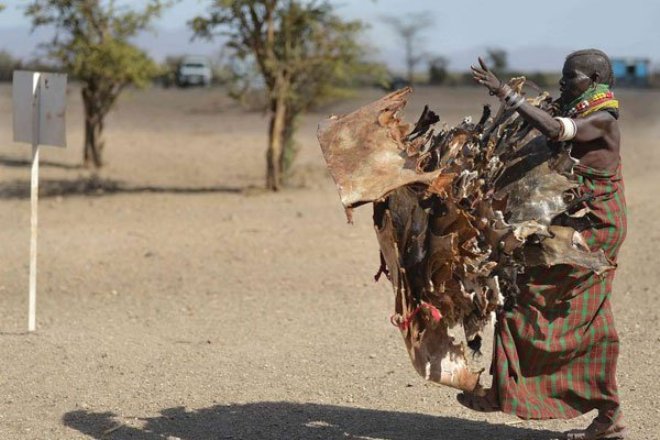
Monday October 9, 2017
A Turkana woman carries hides skinned from goats she has lost to a biting drought that has ravaged livestock population in nothern Kenya near Lokitaung in Turkana county on March 20, 2017. PHOTO | TONY KARUMBA | AFP
Up to 3.4 million Kenyans are facing hunger as a result of prolonged drought, which has affected food production.
Millions of animals, both domestic and wild, are also suffering devastating effects of delayed rains.
The most affected are 19 counties, mostly at the Coast, northern Kenya and Rift Valley, where rains have been inadequate for six years.
In Kajiado County, up to 130,000 households and more than 600,000 cattle are at risk of starvation.
Tana River County had lost 15 per cent of its livestock, County National Drought Management Authority (NDMA) coordinator Abdi Mussa said.
ECONOMIC LOSSES
The economic losses to the herders run into billions of shillings. The drought has also increased human-wildlife conflicts.
In Kilifi, a survey by theNation indicated that most water sources have dried up, forcing residents to travel for long distances to get the commodity for domestic and livestock consumption.
Crop and livestock production has dropped, with the worst hit areas being Ganze, Magarini and Kaloleni sub-counties.
advertisements
County Agriculture Chief Officer Baha Nguma said the drought had affected more than 200,000 people.Mr Nguma said Magarini, Ganze, Malindi and some parts of Kaloleni had recorded high numbers of people going without food, and that most of them lost their livestock last year.
INTERVENTION
“These areas need intervention because soon, the situation will get worse,” he said.
Ganze MP Teddy Mwambire said more than 18,000 people in the constituency are facing hunger.
“Last season, farmers did not harvest and the same is happening now because of less rainfall. This has caused anxiety among locals,” said the MP.
Mr Katana Chengo, a resident at Petanguo, said many residents were running out of alternative sources of food and income.
“We usually depend on charcoal burning but there are no more trees. The place is quickly turning into a desert,” he said.
DROPPED OUT
Mr Katana said the relief food they get from both the national and county government is little.
Many pupils have dropped out of school as they join parents in search of food, water and pasture.
Dodosa Primary deputy headteacher Alex Jambo said school attendance had dropped by more than 20 per cent.He added: “We have more than 400 pupils but many have not been coming to school. As you can see in this classroom, there are supposed to be more than 40 pupils but only a few are here.”
Mr Charo Mashe Nyanje, 58, said he cycles for two-and-a-half hours daily to Kwa Topo reservoir to fetch water.
INADEQUATE RAINS
Mr Hamisi Charo, a herder from Dingiria, said he takes his 50 head of cattle to Giriama Ranch twice a week and is charged Sh400 by a water vendor.
“Last year, I lost 60 animals due to drought,” Mr Charo said.
A farmer from Bandari, Mr Emmanuel Safari, said the area has suffered inadequate rains for the last six years.
Mr Safari is counting losses after his three-and-a-half-acre maize farm withered.
“I haven’t harvested anything yet the last time I received two kilogrammes of relief maize from the government was in July,” said Mr Safari.
WATER
Kilifi Executive for Water Kiringi Mwachitu said the county government has been trucking water to the worst affected areas.
The devolved unit had also drilled boreholes. The national government is also building a mega water dam at Jila.
The county government has also initiated irrigation schemes including Zia Ra Wari, Gandini, Dagamra, Kwa Ndezi, Burangi, Uhai Marikano, Mongotini, Kavunyalalo, Mangudho scheme in Sokoke ward and Mdachi.
The schemes are aimed at reducing reliance on rain fed agriculture.
In Tana River, a fall armyworm infestation has reduced yields in irrigation schemes.
INCREASED CONFLICTS
The pests also attacked pastures and other vegetation.
As a result, conflicts between herders and farmers, especially in Kipini, have increased, said County Commissioner Oningoi ole Sossio.
He said police were pursuing four suspects who slashed cattle belonging to pastoralists and the owner of the cattle, who destroyed farmers’ crops.
County NDMA coordinator Abdi Mussa said some 15 per cent of livestock had died due to drought.
Many residents, he added, had migrated to other counties in search of food, water and pasture.
MALNUTRITION
“About 40 per cent of the community is in need of food. What we receive is barely enough for them. We are only hoping that the coming short rains will help salvage the people from the situation,” he said.
NDMA has distributed 6,000 bags of grain pellets for livestock to three Tana River sub-counties.
Mr Mussa said the situation was worsening due to lack of rains, with children under five years suffering from malnutrition.
Livestock prices at the local markets have dropped by 50 per cent.
WORM INVASION
In Kwale, NDMA coordinator Roman Shera said though the county was experiencing rains, armyworms were threatening food security.
He noted that farmers recorded low yields in the last season due to the armyworm invasion.
He said the national and county governments were cushioning 35,000 households in the county with Sh2,300 a month for the next three months through the Chakula Kwa Jamii programme.
In Lamu, food shortage has been occasioned by displacement of people from their farms due to Al-Shabaab attacks.
DISPLACEMENTS
Some 2,500 people are living in camps. The displacement has left the farms unattended to, leading to destruction of crops by wild animals.
In Taita-Taveta, food prices have skyrocketed.
NDMA said major water sources in the county such as Mwatate Dam had dried up.
NDMA’s Michael Kimithi said some 10,325 households had been enrolled under Chakula Kwa Jamii programme and the first batch of disbursement of Sh2,327 per registered household had been released.